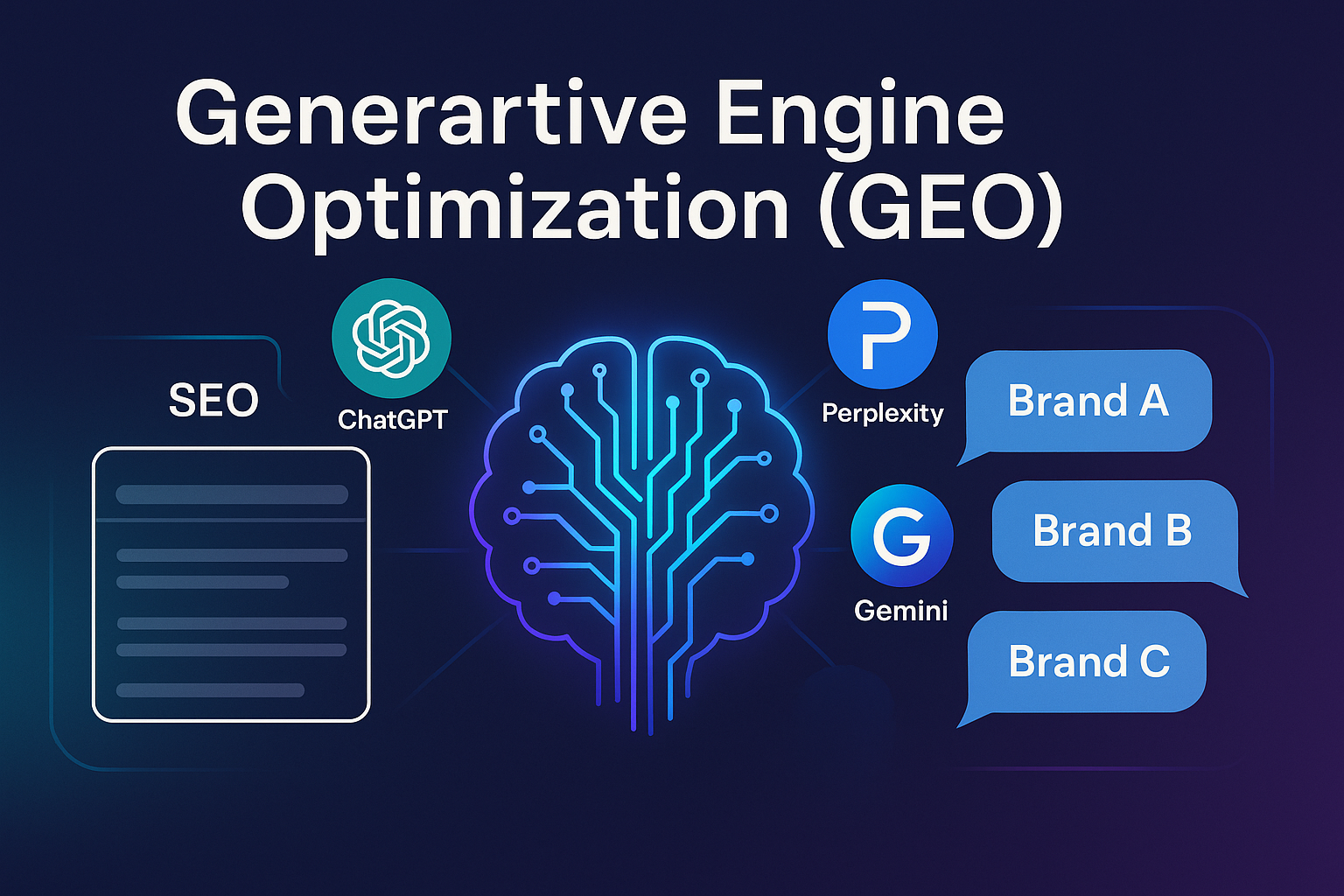What Is GEO?
Generative Engine Optimization (GEO) is the practice of shaping content so that AI tools like ChatGPT, Perplexity, and Gemini present your brand in their answers.
Think of it like this: Search Engine Optimization (SEO) helps your website show up on Google’s results page. GEO, on the other hand, helps your business show up when someone asks an AI assistant a question. Instead of links, the AI often gives direct answers. If your content is well-optimized, your brand becomes part of those answers.
In simple terms, SEO is for search engines. GEO is for generative engines.
How GEO Differs From SEO
SEO and GEO overlap, but they’re not the same.
- SEO focuses on keywords, backlinks, and technical setup to climb the rankings in Google or Bing.
- GEO focuses on entities, context, and credibility so that AI systems recognize your business as the right answer.
Here’s an easy way to see the difference:
- When you Google “best hiking boots,” you get a list of websites ranked by relevance.
- When you ask ChatGPT the same question, it gives you a summary — and the brands it mentions are the winners of GEO.
In other words, SEO is about ranking in a list. GEO is about being named in a conversation.
Why GEO Is Becoming More Important
More people are skipping search engines altogether. Instead, they ask AI tools for recommendations, product advice, or summaries. These AI tools don’t just pull from the top of Google. They draw from a mix of websites, structured data, and trusted sources.
That means businesses can no longer rely only on SEO. If you aren’t mentioned by AI, you may be invisible to the next generation of online shoppers.
Generative engines are essentially the new “gatekeepers” of information. If you want your brand to be part of the conversation, you need to optimize for them.
How Businesses Can Optimize for Generative Engines
So how do you actually “do” GEO? Here are four practical examples:
1. Focus on Entities, Not Just Keywords
AI systems understand entities — people, places, brands, products. For example, instead of just targeting the keyword “best coffee in Boise,” make sure your café is clearly recognized online as a coffee shop in Boise with consistent information across your website, Google Business Profile, and directories.
2. Publish Clear, Authoritative Content
Generative engines prefer trustworthy sources. A dentist writing an in-depth article on “How to Prevent Cavities” is more likely to be cited than a thin blog post written just for keywords. Depth and credibility matter more than keyword stuffing.
3. Use Structured Data and FAQs
Adding structured data (schema markup) to your website helps AI understand your content. FAQs are especially useful. If you own a pest control service, having questions like “How do I get rid of scorpions in Arizona?” directly answered on your site increases the chance that a generative engine will quote you.
4. Build a Strong Digital Footprint
AI pulls from multiple places — your website, social media, reviews, and even press mentions. If your brand is mentioned across platforms and in trusted sources, you’re more likely to appear in AI-generated answers. For example, a local bakery with strong Yelp reviews, active Instagram posts, and local news coverage is far more “visible” to generative engines.
Skills Students Should Learn for GEO Careers
If you’re preparing for a career in digital marketing, GEO is a skillset worth building now. Here are key areas to focus on:
- Entity-based SEO: Learn how to create consistent, clear signals about brands, products, and people.
- Content Authority: Practice writing well-researched, helpful content that builds credibility.
- Structured Data: Understand how to use schema markup and FAQs to make your content machine-readable.
- AI Awareness: Get comfortable testing AI tools like ChatGPT and Perplexity to see how they source and present information.
The marketers who succeed in GEO will be the ones who know how to teach AI to recognize and trust their brands.
Final Thoughts
Search isn’t going away tomorrow, but it’s changing fast. As generative engines become the starting point for information, businesses will shift their strategies to GEO.
For students, this is exciting news. GEO is still new, which means you have a chance to become one of the first experts in a growing field. Learn the skills now, and you’ll be ready to help businesses stay visible in an AI-first world.
Appendix: Evidence that GEO is becoming more important
Because most studies measure adoption and search-like use (not a clean “% of total searches moved from Google”), I’ve labeled the metric type in the table.
Quick take
- Use of chatbots for information seeking is huge and growing—and is described by OpenAI’s new usage paper as a “very close substitute for web search.” OpenAI
- Still, Google remains the default: almost all ChatGPT users also visit Google in the same month. Search Engine Land+1
- In the U.S., LLM adoption is mainstream (34–52% have used them), and a large share of ChatGPT users say they use it as a search engine. Pew Research Center+2Elon University+2
Evidence table (latest available)
| Metric (what it measures) | Geography | Value | Field date | Source |
|---|---|---|---|---|
| Share of ChatGPT users who treat it as a search engine (self-reported) | U.S. | 77% of ChatGPT users | May–Jul 2025 (report Jul 26, 2025) | Adobe Express survey (via SEJ write-up) Search Engine Journal+1 |
| People who prefer ChatGPT over Google for discovery (self-reported) | U.S. | ~24% of surveyed ChatGPT users | May–Jul 2025 | Adobe Express survey (coverage) Search Engine Journal+1 |
| ChatGPT users who also visited Google in the same month | Global (Similarweb panel) | 95.3% | Aug 2025 | Similarweb, reported by Search Engine Land / SERoundtable Search Engine Land+1 |
| Google users who also visited ChatGPT in the same month | Global (Similarweb panel) | 14.3% | Aug 2025 | Similarweb, reported by Search Engine Land / SERoundtable Search Engine Land+1 |
| Effect of adopting ChatGPT on Google usage | Global (clickstream panel) | Google usage did not decline after users started using ChatGPT | Jan 2024–Jun 2025 (published Aug 11, 2025) | Semrush analysis of 260B rows clickstream Semrush |
| ChatGPT weekly users; share of use that is “Seeking Information” (close substitute for web search) | Global | 700M weekly users by Jul 2025; “Seeking Information” named as close substitute for web search | May 2024–Jun 2025 (paper posted Sep 2025) | OpenAI “How People Use ChatGPT” paper (peer-style research report) OpenAI |
| U.S. adults who have ever used ChatGPT | U.S. | 34% | Jun 2025 | Pew Research Center Pew Research Center |
| U.S. adults using LLMs (any: ChatGPT, Gemini, Copilot, Claude) | U.S. | 52% | Feb–Mar 2025 | Elon University national survey Elon University |
| Perplexity monthly active users (MAU) | Global | ~22M MAU | Jul 2025 | DemandSage roundup (compiles public figures) DemandSage |
| Grok monthly active users | Global | ~30.1M MAU | Aug 2025 | Exploding Topics (citing Semrush) Exploding Topics |
How to interpret this
- Replacement vs. supplement: Similarweb + Semrush suggest most people add generative engines to their info-seeking rather than fully replacing Google (yet). Search Engine Land+1
- Search-like behavior is real: OpenAI’s usage paper classifies a large chunk of interactions as “Seeking Information,” explicitly calling it a “very close substitute for web search.” That strengthens the case that GEO matters, even if displacement isn’t 1:1. OpenAI
- U.S. momentum: With 34–52% of U.S. adults having used LLMs and 77% of ChatGPT users saying they use it as a search engine, students and brands should expect more queries to start in generative engines. Pew Research Center+2Elon University+2
What’s still missing (and why)
No high-quality, public dataset yet gives a definitive “% of total searches now performed in generative engines by region.” Platforms don’t publish that, and web analytics panels can only infer substitution. Until then, the best approach is to triangulate from:
- Adoption & use-case studies (OpenAI paper; Pew; Elon),
- Behavioral overlap (Similarweb), and
- Clickstream impact (Semrush). Semrush+4OpenAI+4Pew Research Center+4



